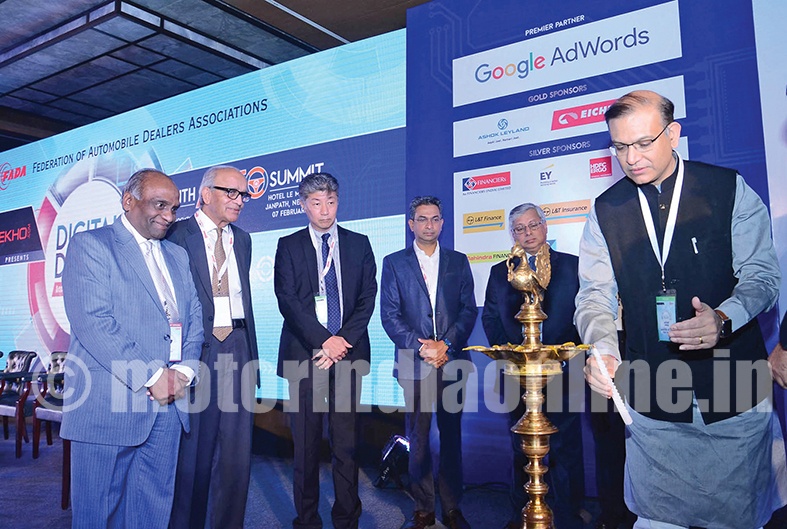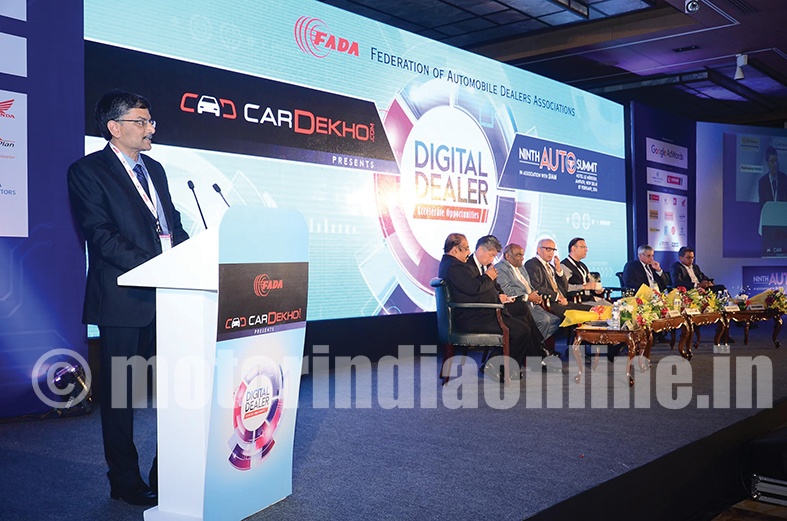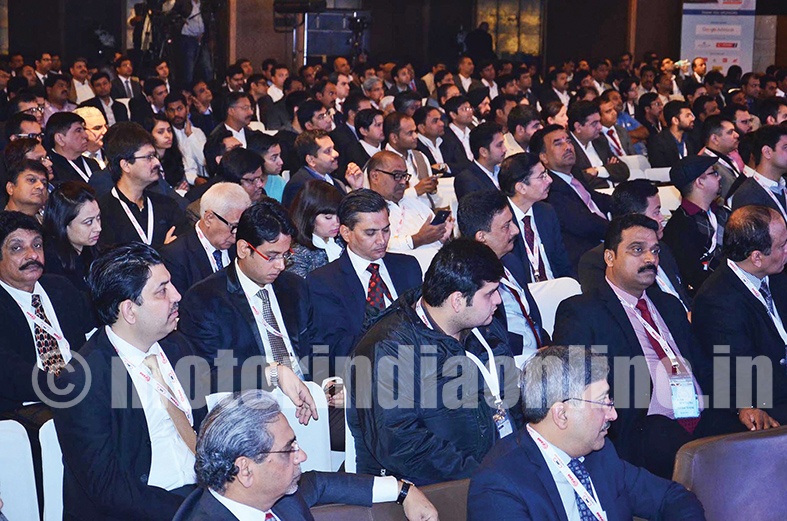The Federation of Automobile Dealers Associations (FADA), in association with CarDekho, presented the 9th Auto Summit, themed “Digital Dealer – Accelerate Opportunities”. The biennial conference underlined the standing of the digital ecosystem in today’s automobile business across all the segments of the industry.

The day-long summit zeroed in on various B2C technologies like virtual showrooms and augmented reality platforms along with several B2B technologies solutions like the lead management system, branding solutions, digital marketing and other cloud solutions.
Around 600 automotive dealers from across the country attended the event, which unfolded with an inaugural session and a welcome address by Mr. Jayant Sinha, Minister of State for Finance, followed by addresses by Mr. R.C. Bhargava, Chairman, Maruti Suzuki India, Mr. Rajan Anandan, Vice President & Managing Director, Google South East Asia & India, Mr. Ravi Pisharody, Vice President, SIAM and ED Tata Motors CVBU, Mr. K.V.S. Prakash Rao, FADA President, and Dr. Kailash Gupta, Chairman, Auto Summit 2016.

Mr. K.V.S Prakash Rao, in his welcome address, urged the Government to give top priority to the auto retail sector. He said: “The auto market is passing through a developmental phase and there is a need to appreciate the members of the ecosystem like manufacturers, OEMs, dealers and the disruption that is caused by the e-commerce companies. The organised retail industry has truly evolved over the years. Although it has got the attention of the government agencies for other sectors; we would also want them to to focus on auto retail which is one of the largest employers and has a significant turnover.”
Mr. Jayant Sinha lauded the automobile industry for being one of the largest generators of jobs in the country and contributing tremendously to the Indian economy in terms of products and services for both rural and urban consumers. “The work that the industry has done for promoting and encouraging “Make in India’ and the work that they will be doing in the future will be extraordinarily important for the Indian economy.”
He also harped on the vitality of GST in India as it would lead to the removal of a a lot of tax-related anomalies attached to the industry. “The automotive industry is one of the worst affected as there are multiple layers of tax structure which ultimately drives up the cost of the vehicles. This is a burning issue and we are seriously looking to address it in a systematic manner,” he added.

Mr. Ravi Pisharody stated: “The history of the auto industry is represented by many of the people from the FADA community. In our industry, executives come and go. But many of the dealers remain loyal to their OEMs across three generations in the 50 years of its formation. After buying a commercial vehicle, it is the aftersales service experience, spareparts availability, and the cost of operations in the next three to four years that determine the reputation of the OEM. If we don’t raise the bar, the consumer will not come back to us. And now consumers are more digital savvy and purchase the products and get them serviced through the online route. With the influx of taxi hailing apps, there are new business models that are emerging fast. From a dealership point of view, there are several regions to embrace digitalisation. Moreover, there are challenges too in terms of getting quality manpower in the current era. And embracing the digital route provides an opportunity for dealers to attract new and young talent.”
Padma Bhushan, R.C. Bhargava expressed his view that the automobile industry will lead the ‘Make in India’ initiatives. “The automobile industry has been and will always be at the forefront among other industries in India. The Prime Minister has told us that we need manufacturing in order to find jobs for young people. There is no other alternative to this, and I believe our industry will lead the way in the future to ‘make in India’. Therefore, it is our duty to support the Prime Minister and the Government and ensure that this industry moves even faster. I think the industry is completely aware of its responsibility in the areas of safety and pollution, and we will continuously work on improving our efforts and success in both these areas. We must also remember that pollution in India is very different from developed countries where the automobiles are primarily polluting in terms of nitrogen oxides. That has to be built into policy. Otherwise we might think that we are making a great effort in curbing pollution.”
There were other speakers too, who in their address to the dealers and the automobile fraternity, brought out the necessity of proactive presence in digital space having become imperative for a competitive edge in the digital and communication era. Most of them were unanimous in their view that the digital medium intends to help acquire new customers and provide support in plugging leakages in order to improve productivity and efficiency.
The sessions were themed around key topics such as ‘The Digital Dealer: Glimpse into the Future’, ‘Where are my Leads’, ‘Digital Marketing’, and ‘Improving Dealer Profitability through Digital’. The sessions, laid strong emphasis on the role of digital for brand building, buyer search, lead generation and conversion of sales and service.
As Mr. Rajan Anandan affirmed: “Software can reinvent industries, and in a few years to come, the Internet will impact businesses which do not actually have a digital product. Consumer experience would change massively in the coming years owing to the Internet. As OEMs look for maximizing sales in the hyper-competitive world, they would have to transform dealership, and service experience through imbibing technology. From our survey, we have learnt that 75% buyers do online for the car purchase and 54% change their consideration after research. They search for right affordability, dealership and service, and it is important to exploit the Internet opportunities.”